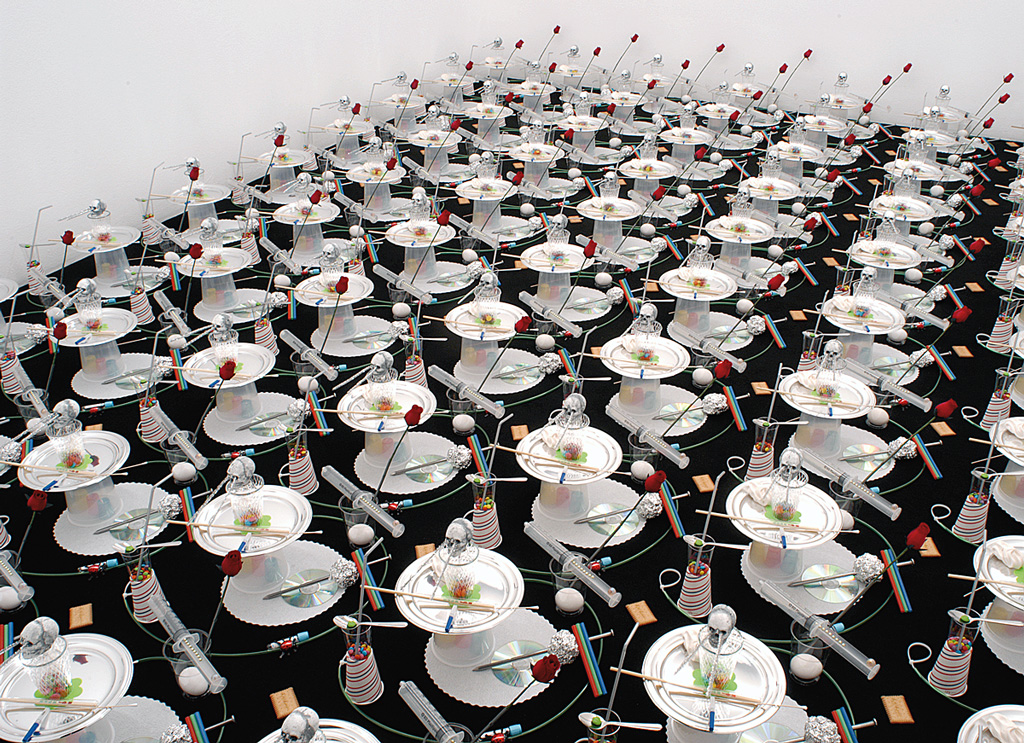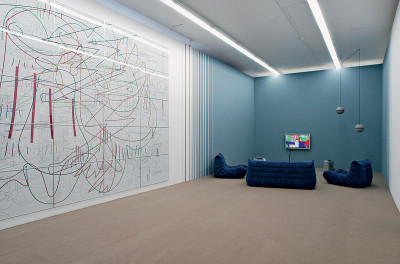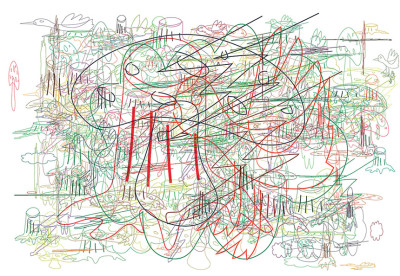Hans Rudolf Reust in ArtForum
Hervé Graumann – Geneva – installations by the artist are on display at the Musee d’art moderne et contemporain
ArtForum, Sept, 2003 by Hans Rudolf Reust
That Raoul Pictor is a painter is obvious. Wearing a black beret and the white smock of his profession, he paces back and forth in his studio in search of inspiration, from the stool to the bookshelf to the table where a wineglass stands and then over to the easel. Wildly, he dunks a thick brush and begins to paint, accompanied by the sounds of splattering pigment. By the time he takes his masterpiece down from the easel and carries it off, we’ve still seen only the back of the canvas–and, indeed, we can only view the completed artwork by printing it out. With Raoul Pictor, Hervé Graumann has created a virtual painter who pursues the aura of the painted original via the random constellation of a computer-generated image. With the click of a mouse, our dear painter will paint as many pictures as we like. The auctorial gesture of painting serves to animate the black-box image production of the computer processor, which is ultimately invisible. The computer as artist, assuming it has an intelligence distinguishable from the designs of its programmers, wears every face and no face at all. So why not the one under the beret of a Montmartre painter?
At the exhibition in Geneva, this piece, Raoul Pictor cherche son style… (Raoul Pictor searches for his style…), 1993, could be navigated from the sofa in a small lounge, bringing a living-room mode of perception into the museum while ironizing the aesthetics of image consumption in the ’90s. L.o.s.t., 1997, Graumann’s piece for Documenta 10, was housed exclusively on the Web. In a luminous white circle controlled by the mouse, like the beam of a searching flashlight, fragments of a text appear–traces of language in the search for a network of lost existence, ending in an offer of contact with a cryptic e-mail address, perhaps that of the person lost. The blackened monitor screen becomes a metaphor for the dark, incomprehensible side of global connectedness.
In comparison, the installation of Pattern–Vanité 2b, 2003, which filled one of the bays at MAMCO such that it became inaccessible, seems easily comprehensible. Graumann worked for a time in the neuroscience and dermatology department at a hospital in Geneva, and here he created a sculpturally fantastic ensemble from the little objects one typically finds by a patient’s bed: Surrounded by the sweeping oval of a cannula, pill cups in primary colors are piled up along with a gleaming, silver-colored plastic plate topped with meringue; a CD shining in rainbow colors rests on a paper doily with an enormous nail that has pierced a tin-foil ball; on the very top of the plastic-cup tower is a little polystyrene skull with silver rays (in the form of pipe cleaners) beaming from its dark eye sockets, gleaming in the bright museum light. Next to this is a still life with a breakfast egg, a red rose, and a large syringe. The many elements of this nature morte alternate between the traditional meanings of a memento mori and the contemporary realities of high technology in medicine. On the floor, through the perfectly executed repetition of the same filigree, eighty times, a hallucinatory pattern emerges–threatening to reproduce endlessly and to absorb the entire world. The fascination of glittery Christmas decorations in a store display is combined here with the fear of the uncontrollable growth of one’s own cells.

Pattern – Vanité 2b, 2003 – installation, objets divers / installation, sundry objects – 400 x 500 cm.
–Hans Rudolf Reust Translated from German by Sara Ogger.
© 2003 Artforum International Magazine, Inc.
© 2003 Gale Group

